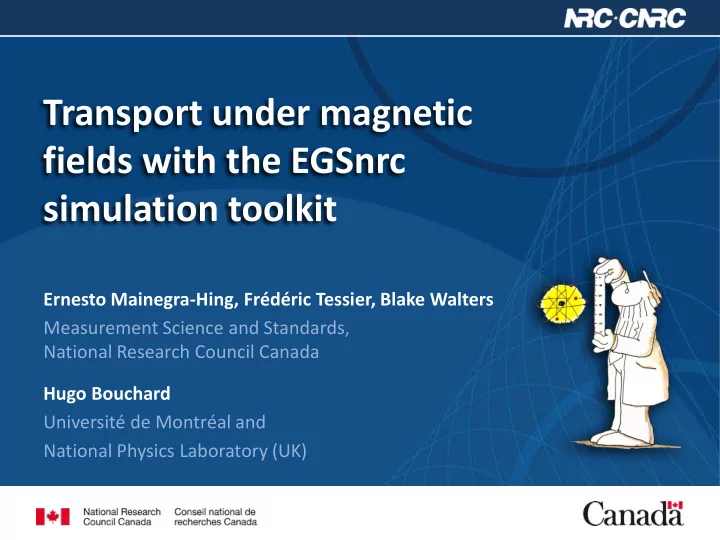

Transport under magnetic fields with the EGSnrc simulation toolkit Ernesto Mainegra-Hing, Frédéric Tessier, Blake Walters Measurement Science and Standards, National Research Council Canada Hugo Bouchard Université de Montréal and National Physics Laboratory (UK)
MRI MRI-guided Radiation Therapy = + External RT
Magnetic field effect on dose distribution
pencil beam of 10 MeV electrons air water electron tracks
pencil beam of 10 MeV electrons air water electron tracks B = 1 T
pencil beam of 10 MeV electrons air electron water return effect air B = 1 T water
air 60 Co PTW30013 B
PTW chamber irradiated by parallel 60 Co beam significant dependence on magnetic field New dosimetry? cavity
Orange Bible
Equation of motion The equation of motion in the force formulation for transport in a medium under the effect of an EM field can be written as 𝑢 1 𝑤 = 𝑤 0 + 𝑛 0 𝛿 𝐹 𝑒𝑢′ 𝑮 𝒇𝒎 𝐹 𝑢′ + 𝑮 𝒋𝒐 𝐹 𝑢′ + 𝑮 𝒇𝒏 𝑦 𝑢′ , 𝐹 𝑢′ , 𝑣 𝑢′ 0 deterministic stochastic
Bielajew’s implementation Under the assumption of very small steps such that: • Field does not changes significantly • Energy loss negligible • Negligible angular deflection the equation of motion becomes to first order: 𝑢 𝑤 = 𝑤 0 + 𝑮 𝒇𝒎 𝐹 0 + 𝑮 𝒋𝒐 𝐹 0 + 𝑮 𝒇𝒏 𝑦 0 , 𝐹 0 , 𝑣 0 𝑛 0 𝛿 𝐹 0
Bielajew’s implementation Under the assumption of very small steps such that: • Field does not changes significantly • Energy loss negligible • Negligible angular deflection the equation of motion becomes to first order: 𝑢 𝑤 = 𝑤 0 + ∆𝑤 𝑁𝐷 + 𝑮 𝒇𝒏 𝑦 0 , 𝐹 0 , 𝑣 0 𝑛 0 𝛿 𝐹 0 Interactions with medium and external field treated independently!
Bielajew’s implementation Expressing the time t as a function of the total path length D s to first order gives 0 ∆𝑡 + ∆𝑡 ∆𝑦 = 𝑣 2 ∆𝑣 Neglecting lateral deflection D s/2 one gets for the position change ∆𝑦 = 𝑣 0 ∆𝑡 MC step the change in the particle’s direction is ∆𝑣 = ∆𝑣 𝑁𝐷 + ∆𝑣 𝑓𝑛
𝑠 = 𝑛𝑑 𝛿 2 − 1 𝑓𝐶 vacuum
vacuum
3 kinds of errors vacuum
1. error in position vacuum
2. error in radius vacuum
3. error in energy deposition (in medium) vacuum
1 vacuum
0.84 vacuum
0.58 vacuum
0.01 forever vacuum
Fano theorem provides a rigorous test • Uniform electron source per unit mass N 0 /m T • Medium of uniform composition but varying density 𝐸 = 𝑂 0 /𝑛 𝑈 ∙ 𝐹 where 𝐹 is the average energy emitted
Fano theorem provides a rigorous test If the source emits electrons of energy E 0 : 𝐸 / 𝑂 0 = 𝐹 0 /𝑛 𝑈 For a MC simulation fulfilling Fano conditions, the dose per particle in any region i is expected to be: 𝐸 𝑗 / 𝑂 0 = 𝐹 0 /𝑛 𝑈 Use this to verify the accuracy of the electron transport algorithm!
“Fano’s theorem does not hold in the presence of static and constant external EM fields. This has the unfortunate consequence of invalidating the Fano cavity test …”
1. Isotropic uniform source per unit mass 2. Magnetic field B scales with mass density
0.001 0.01 0.1 1 identical atomic properties (air) 2 cm in water phantom
0.001 0.01 0.1 1 uniform source of electrons, per unit mass 100 keV electron in water tracks phantom
1.01 0.001 0.01 0.1 1 0 T Monte Carlo / Theory 1.00 this is what we mean when we say that EGSnrc is accurate at the 0.1% level in water phantom 0.99
Fano test 1 d > R CSDA (E max ) (PTW30013) water d d d d Same material, different densities 12 regions
?
Fano test 1 for a PTW30013 water Same material, different densities 12 regions
Powerful diagnostic tool !!!
PTW30013 cavity dose
1 MeV PTW30013 cavity dose
Measuring efficiency 1 ξ = 𝑡 2 × 𝑈 𝐷𝑄𝑉 How long needed to achieve desired uncertainty?
cavity dose
cavity dose
Conclusionss Transport in electromagnetic field is available in EGSnrc as a first-order correction on the velocity. Ionization chamber dose response calculations pass Fano test in a magnetic field only with significant step size restrictions. Larger step sizes are possible as energy increases or field strength decreases (curvature radius increases) Considering the penalty in efficiency, a more accurate algorithm allowing larger step sizes is desirable. Fano test: powerful tool for benchmarking radiation transport algorithms and testing the correctness of MC simulation parameters.
Transport under magnetic fields with the EGSnrc simulation toolkit Ernesto Mainegra-Hing, Frédéric Tessier, Blake Walters Measurement Science and Standards, National Research Council Canada Hugo Bouchard Université de Montréal and National Physics Laboratory (UK)
Recommend
More recommend